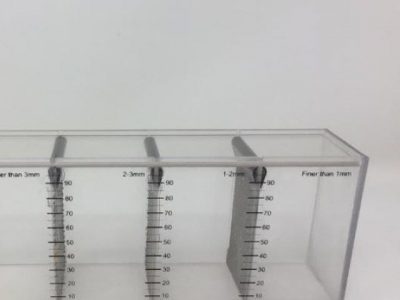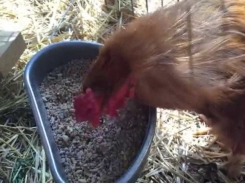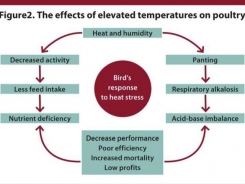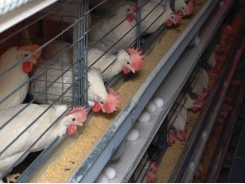Crumbler, crumble quality influence broiler growth

Production of uniform crumbles requires alignment with the same clearance across the width of the rolls.
Improvements in genetic selection and more precise nutrition have allowed birds to reach market weight in a shorter period of time. Therefore, pre-starter and starter periods represent a greater percentage of a broiler's life. With this in mind, it is critical to offer a feed that is more palatable to hatched chicks during the pre-starter and/or starter period to help improve feed intake during the first week.
During their lifetime, broilers may receive feed in the form of mash, crumbles, short pellets or micro pellets. However, due to limitations in beak size, newly hatched chicks cannot easily consume whole pellets; therefore mash, crumbles or micro pellets must be offered during this critical period.
According to Michard and Rouxel (2015), small chicks have a preference for particles between 1.5 mm and 2.0 mm. In a more recent study, Rubio et al. (2017) evaluated the effect of feed form (mash, crumbles and 3.3. mm micro pellets) during the starter period (days 1-14) on broiler performance and processing yield at 35 days. The authors reported that broilers fed mash diets during the starter period had lower bodyweight and feed intake at 14 and 35 days, respectively, and breast meat weight was approximately 30 g lower at 35 days compared to broilers fed either 3.3 mm micro pellets or crumbles.
Crumblers are used in the feed mill to break down pellets into small crumbles without producing excessive amounts of fine particles (less than 1 mm). A crumbler is essentially a one-set roller mill with two corrugated, cast-hardened metal rolls mounted on anti-friction bearings and attached to a steel frame, which guarantees proper alignment of the rolls and keeps them parallel.
Crumbles are formed by the shearing and crushing action produced between a fast- and a slow-moving roll. The size of crumbles is controlled by adjusting the gap opening between the rolls using adjusting screws on each side of the frame.
Some equipment may require individual roll adjustment to align the rolls. The adjusting screws are designed with an internal spring mechanism to automatically open the rolls if any oversized or foreign material is accidentally introduced into the stream of pellets. If the crumbler rolls need individual adjustment on both sides, a good practice is to count the number of turns when opening or closing the screws on the crumble rolls, and then take samples from different places in the crumbler to ensure crumble uniformity.
Some manufacturers supply crumblers with a single adjusting mechanism and a geared connection, which allows the operator to adjust both ends of the rolls from a single point, eliminating the problem of keeping the rolls in parallel. In addition, crumblers have bypass mechanisms that operate manually or pneumatically to bypass the crumbler when pellets need to be produced. In general, the feed industry uses a pneumatic bypass mechanism as it can be controlled by the automation system, allowing for more efficient changeovers between crumbled and pelleted diets.
In order to produce uniform crumbles, the rolls have to be aligned with the same clearance across the width of the rolls, and pellets must be fed uniformly across the entire width, which promotes a consistent wear of the rolls. Inconsistent or uneven feed distribution leads to uneven wear of the rolls, which can negatively influence crumble uniformity and create more fines due to attrition of pellets. In addition, pellets should be fed in a gentle but constant stream to make sure the rolls break down each pellet individually.
One easy way to verify proper alignment of the rolls is to collect and visually compare samples from each end of the rolls as well as the center. A screen analysis is recommended, because differences in crumble size are hard to appreciate with the naked eye.
One of the tools available in the industry is a sieve shaker, which separates the crumbles into four categories based on particle size. Using this methodology, the operator can take a sample, split it using an approved divider, weigh out 100 g, place it into the sieve shaker and then manually shake it to separate the particles (<1 mm, 1-2 mm, 2-3 mm and >3 mm). Although very limited research is available, between 70% and 80% of the crumbles should be retained in the middle compartments (1-3 mm).
According to the "Aviagen Broiler Management" handbook, the size of the crumbles offered during the starter period should be: 15% greater than 3 mm, 40% between 2 mm and 3 mm, 35% between 1 mm and 2 mm and 10% less than 1 mm. Moreover, pellets must be properly dried by managing the cooling system, as moist pellets are prone to producing more fines during crumbling.
One important thing to consider is the pellet diameter produced. Since a major segment of the feed industry produces pellets ranging in diameter from 11/64 in. to 3/16 in. (4.36 mm to 4.76 mm), crumble rolls with a diameter of 6 in. or 8 in. or larger will work for most situations. Generally, the distance between the rolls should be approximately two-thirds of the diameter of the pellet being produced. For example, if you are producing 12/64 in. (4.36 mm) diameter pellets, the distance between the crumble rolls should be about 8/64 in. (3.175 mm).
Few studies have evaluated the effect of crumble size and quality on subsequent chick performance. However, crumbles with high levels of fines (under 1 mm) could increase feed wastage, reduce feed efficiency, increase dustiness inside the farm and increase water intake, which could lead to poor litter conditions and increase the risk of footpad dermatitis.
On the other hand, coarse crumbles (larger than 3 mm) could stimulate selective feeding and contribute to feed segregation. Since the size of the crumble can influence the subsequent development of the broilers, it is important to offer newly hatched chicks good-quality and uniform crumbles during their first days of age.
References
Michard, J., and L. Rouxel. 2015. Feeding micro-pellets to newly hatched chicks to improve growth rate. Int. Hat. Pr. 28(4): 21-23.
Rubio, A., W. Dozier, E. Lezcano and W.J. Pacheco. 2017. Effects of feed form during the starter period on productive and processing performance of broilers. Abstr. M84. Southern Poultry Science Society Meeting.
*Dr. Charles Stark is the Jim & Carol Brown associate professor in feed technology at Kansas State University. Dr. Adam Fahrenholz is assistant professor in the Prestage department of poultry science at North Carolina State University. Dr. Wilmer Pacheco is an extension specialist and assistant professor in the department of poultry science at Auburn University.
Related news
Tools

Phối trộn thức ăn chăn nuôi

Pha dung dịch thủy canh

Định mức cho tôm ăn

Phối trộn phân bón NPK

Xác định tỷ lệ tôm sống

Chuyển đổi đơn vị phân bón

Xác định công suất sục khí

Chuyển đổi đơn vị tôm

Tính diện tích nhà kính

Tính thể tích ao




 Selecting dietary energy levels for layers
Selecting dietary energy levels for layers  Low protein feed, fewer eggs but better bottom…
Low protein feed, fewer eggs but better bottom…